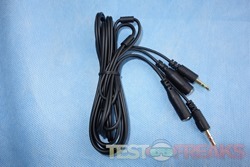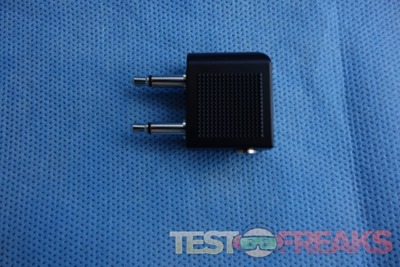Testing and Usage
For testing the HyperX Cloud, I used a PC, MacBook Air, iPhone 5S and iPad Mini. Since these are primarily used for gaming I first hooked them up to my gaming PC.
Testing the HyperX Cloud headset involves plugging them into a computer directly into the PC’s audio input/output port. You can run the headset in directly and control its volume using the operating system’s audio control or my personal preference, through the inline control box. This connector plugs into the PC and then has connectors for the HyperX Cloud. From here the audio can be adjusted from the inline controller.
Kingston provides numerous cable extenders and adapters to allow the HyperX Cloud to work with most any input. A two-meter extension cable will help reach even the farthest device input. The smartphone/tablet adapter allows the HyperX Cloud to connect to a laptop or mobile device (phone or tablet) that has a single audio jack.
You can even use the HyperX Cloud while flying the friendly skies with the included airplane adapter.
Since these cans are designed for gaming, this was one of the first modality used to test the HyperX Cloud. Playing Titanfall and Skyrim provided excellent sounding gaming environments for these headphones. Gameplay sounded excellent with an immersive feel although the lack of built in surround sound drivers made positional localization based on audio for a shooter like Titanfall a non-factor.
The microphone quality was good as well. My voice was clear with minimal distortion. In fact I was able to use the HyperX Cloud with Dragon Dictate to verbally transcribe some of this review.
Another use for the HyperX Cloud is listening to music. For testing I listen to the latest albums from Tom Petty, Unisonic and Paul Gilbert, which gave HyperX Cloud a chance to represent classic rock, metal/hard rock and instrumental genres.
The headset has a rich deep sound with a lot of bass especially when using the leather covered ear cups. While there is plenty of low end, these are not the bass saturated Beats headphones; which is a good thing. Switching to the velour ear cups changes the sound stage to a more a subdued timbre.
Finally, for watching video the HyperX Cloud held its own. Movies were immersive, explosions were forceful and quiet moments had no audible artifacts or hiss.
In terms of comfort, while there is no shortage of padding with the HyperX Cloud. The closed back design provides good sound isolation although the leatherette ear pads did cause my ears to get damp from perspiration; the additional velour cups did however alleviate this issue. Switching between the two ear cups did involve some maneuvering to fit the replacement set onto the HyperX Cloud.
There are not too many knocks against the HyperX Cloud but another one that comes to mind is the main cable is not removable or user replaceable without requiring soldering skills.
When not using the HyperX Cloud, carrying it around with all of its accessories is easy using the included cloth satchel.




2 comments for “Review of Kingston HyperX Cloud Headset”